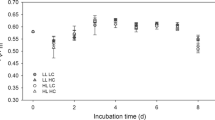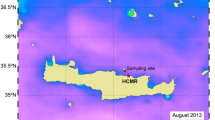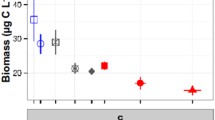Abstract
Increasing pCO2 is hypothesized to induce shifts in plankton communities toward smaller cells, reduced carbon export rates and increased roles of gelatinous zooplankton. Appendicularians, among the most numerous pan-global “gelatinous” zooplankton, continuously produce filter-feeding houses, shortcutting marine food webs by ingesting submicron particles, and their discarded houses contribute significantly to carbon fluxes. We present a first mesocosm-scale study on the effects of temperature, pCO2 and bloom structures on the appendicularian, Oikopleura dioica. There were effects of temperature and nutrients on phytoplankton communities. No shifts in functional phytoplankton groups, nor changes in particle sizes/morphotypes, known to impact appendicularian feeding, were observed under manipulated pCO2 conditions. However, appendicularian abundance was positively correlated with increased pCO2, temperature and nutrient levels, consistent with hypotheses concerning gelatinous zooplankton in future oceans. This suggests appendicularians will play more important roles in marine pelagic communities and vertical carbon transport under projected ocean acidification and elevated temperature scenarios.






Similar content being viewed by others
References
Alldredge AL (2005) The contribution of discarded appendicularian houses to the flux of particulate organic carbon from ocean surface waters. In: Gorsky G, Yongbluth MJ, Deibel D (eds) Response of marine ecosystems to global change. Contemporary Publishing International, Paris, pp 309–326
Azam F, Fenchel T, Field JG, Gray JS, Meyer-Reil LA, Thingstad F (1983) The ecological role of water-column microbes in the sea. Mar Ecol Prog Ser 10:257–263
Banse K (1995) Zooplankton: pivotal role in the control of ocean production. ICES J Mar Sci 52:3–4
Bauerfeind E, Garrity C, Krumbholtz M, Ramseier RO, Voss M (1997) Seasonal variability of sediment trap collections in the Northeast Water Polynya. 2. Biochemical and microscopic composition of sedimenting matter. J Mar Syst 10(1–4):371–389
Beardall J, Raven JA (2004) The potential effects of global climate change on microalgal photosynthesis, growth and ecology. Phycologia 43(1):26–40
Bouquet J-M, Spriet E, Troedsson C, Otterå H, Thompson EM (2009) Culture optimization for the emergent zooplanktonic model organism Oikopleura dioica (Larvacean). J Plankton Res 31(4):359–370
Caldeira K, Wickett ME (2003) Oceanography: anthropogenic carbon and ocean pH. Nature 425:365
Dickson AG, Millero FJ (1987) A comparison of the equilibrium constants for the dissociation of carbonic acid in seawater media. Deep-Sea Res 34:1733–1743
Doney SC, Balch WM, Fabry VJ, Feely RA (2009) Ocean acidification: a critical emerging problem for the ocean sciences. Oceanography 22:16–25
Dupont S, Havenhand J, Thorndyke W, Peck L, Thorndyke MC (2008) CO2-driven ocean acidification radically affect larval survival and development in the brittlestar Ophiothrix fragilis. Mar Ecol Prog Ser 373:285–294
Dupont S, Olga-Martínez O, Thorndyke M (2010a) Impact of near-future ocean acidification on echinoderms. Ecotoxicology 19:449–462
Dupont S, Lundve B, Thorndyke M (2010b) Near future ocean acidification increases growth rate of the lecithotrophic larvae and juveniles of the sea star Cross aster papposus. J Exp Zool B 314B:382–389
Engel A, Zondervan I, Aerts K, Beaufort L, Benthien A, Chou L, Delille B, Gattuso JP, Harlay J, Heemann C, Hoffmann L, Jacquet S, Nejstgaard J, Pizay MD, Rochelle-Newall E, Schneider U, Terbrueggen A, Riebesell U (2005) Testing the direct effect of CO2 concentration on a bloom of the coccolithophorid Emiliania huxleyi in mesocosm experiments. Limnol Oceanogr 50:493–504
Erga SR, Heimdal BR (1984) Ecological studies on the phytoplankton of Korsfjorden, western Norway. The dynamics of a spring bloom seen in relation to hydrographical conditions and light regime. J Plankton Res 6:67–90
Fabry VJ, Seibel BA, Feely RA, Orr JC (2008) Impacts of ocean acidification on marine fauna and ecosystem processes. ICES J Mar Sci 65:414–432
Feely RA, Sabine CL, Lee K, Berelson W, Kleypas J, Fabry VJ, Millero FJ (2004) Impact of anthropogenic CO2 on the CaCO3 system in the oceans. Science 305(5682):362–366
Fernandez D, Lopez-Urrutia A, Fernandez A, Acuna JL, Harris R (2004) Retention efficiency of 0.2 to 6 mu particles by the appendicularian Oikopleura dioica and Fritillaria borealis. Mar Ecol Prog Ser 266:89–101
Flood P, Deibel D (1998) The appendicularian house. In: Bone Q (ed) The biology of pelagic tunicates. Oxford University Press, Oxford, pp 105–124
Fortier L, Le Fèvre J, Legendre L (1994) Export of biogenic carbon to fish and to the deep ocean: the role of large planktonic microphages. J Plankton Res 16(7):809–839
Jakobsen HH, Carstensen J (2011) FlowCAM: sizing cells and understanding the impact size distributions on biovolume of planktonic community structure. Aqua Microb Ecol 65:75–87
Kroeker KJ, Kordas RL, Crim RN, Singh GG (2010) Meta-analysis reveals negative yet variable effects of ocean acidification on marine organisms. Ecol Lett 13:1419–1434
Legendre L, Michaud J (1998) Flux of biogenic carbon in oceans: size-dependent regulation by pelagic food webs. Mar Ecol Prog Ser 164:1–11
Legendre L, Rivkin RB (2002) Pelagic food webs: responses to environmental processes and effects of the environment. Ecol Res 17:143–149
Lewis E, Wallace DWR (1998) CO2SYS: program developed for the CO2 system calculations. Carbon Dioxide Inf. Anal. Center report ORNL/CDIAC-105
Lohbeck KT, Riebesell U, Reusch TBH (2012) Adaptive evolution of a key phytoplankton species to ocean acidification. Nat Geosci online early doi:10.1038/NGEO1441
Lopez-Urrutia A, Harris RP, Smith T (2004) Predation by calanoid copepods on the appendicularian Oikopleura dioica. Limnol Oceanogr 49:303–307
McDonald JH (2009) Handbook of biological statistics, 2nd edn. Sparky House Publishing, Baltimore
Meehl GA, Stocker TF, Collins WD, Friedlingstein P, Gaye AT, Gregory JM, Kitoh A, Knutti R, Murphy R, Noda A, Raper SCB, Watterson IG, Weaver AJ, Zhao Z-C (2007) Global climate projections. Chapter 10 in climate change 2007: the physical science basis. In: Solomon S, Qin D, Manning M, Chen Z, Marquis M, Averyt KB, Tignor M, Miller HL (eds) Contribution of working group I to the fourth assessment report of the intergovernmental panel on climate change. Cambridge University Press, Cambridge
Mehrbach C, Culberson CH, Hawley JE, Pytkowicz RM (1973) Measurement of the apparent dissociation constants of carbonic acid in seawater at atmospheric pressure. Limnol Oceanogr 18:897–907
Melzner F, Gutowska MA, Langenbuch M, Dupont S, Lucassen M, Thorndyke MC, Bleich M, Portner HO (2009) Physiological basis for high CO2 tolerance in marine ectothermic animals: pre-adaptation through lifestyle and ontogeny? Biogeosciences 6:2313–2331
Millero FJ, Woosley R, DiTrolio B, Waters J (2009) Effect of ocean acidification on the speciation of metals in seawater. Oceanography 22(4):72–85
Moran XAG, Lopez-Urrutia A, Calvo-Diaz A, Li WKW (2010) Increasing importance of small phytoplankton in a warmer ocean. Glob Change Biol 16(3):1137–1144
Nejstgaard JC, Frischer ME, Verity PG, Anderson JT, Jacobsen A, Zirbel MJ, Larsen A, Martínez-Martínez J, Sazhin AF, Walters T, Bronk DA, Whipple SJ, Borett SR, Patten BC, Long JD (2006) Temporal patterns in planktonic food web development in mesocosms with nutrients and Phaeocystis added. Mar Ecol Prog Ser 321:99–121
Orr JC, Caldeira K, Fabry V, Gattuso J-P, Haugan P, Lehodey P, Pantoja S, Pörtner H-O, Riebesell U, Trull T, Urban E, Hood M, Broadgate W (2009) Research priorities for understanding ocean acidification: summary from the second symposium on the ocean in a high-CO2 world. Oceanography 22(4):182–189
Paasche E, Østergren I (1980) The annual cycle of plankton diatom growth and silica production in the inner Oslofjord. Limnol Oceanogr 25:481–494
Parsons TR, Maita Y, Lalli CM (1984) A manual of chemical and biological methods for seawater analysis. Pergamon Press, Oxford
Porter KG, Feig YS (1980) The use of DAPI for identifying and counting aquatic microflora. Limnol Oceanogr 25:943–948
Purcell JE (2005) Climate effects on formation of jellyfish and ctenophore blooms: a review. J Mar biol Ass UK 85:461–476
Raven J, Caldeira K, Elderfield H, Hoegh-Guldberg O, Liss P, Riebesell U, Shepherd J, Turley C, Watson A (2005) Ocean acidification due to increasing atmospheric carbon dioxide. Policy Document no 12/05. Royal Society, London
Reinfelder JR (2011) Carbon concentrating mechanisms in eukaryotic marine phytoplankton. Annu Rev Mar Sci 3:291–315
Riebesell U, Bellerby RGJ, Grossart H-P, Thingstad TF (2008) Mesocosm CO2 perturbation studies: from organism to community level. Biogeosciences 5:1157–1164
Riebesell U, Koertzinger A, Oschlies A (2009) Sensitivities of marine carbon fluxes to ocean change. PNAS 106(49):20602–20609
Robison BH, Reisenbichler KR, Sherlock RE (2005) Giant larvacean houses: rapid carbon transport to the deep sea floor. Science 308(5728):1609–1611
Sabine CL, Feely RA, Gruber N, Key RM, Lee K, Bullister JL, Wanninkhof R, Wong CS, Wallace DWR, Tilbrook B, Millero FJ, Peng T-H, Kozyr A, Ono T, Rios AF (2004) The oceanic sink for anthropogenic CO2. Science 305:367–371
Sarazin G, Michard G, Prevot F (1999) A rapid and accurate spectroscopic method for alkalinity measurements in seawater samples. Water Res 33:290–294
Sazhin AF, Artigas LF, Nejstgaard JC, Frischer ME (2007) The colonization of two Phaeocystis species (Prymnesiophyceae) by pennate diatoms and other protists: a significant contribution to colony biomass. Biogeochemistry 83:137–145
Sokal RR, Rohlf FJ (1995) Biometry; the principles and practice of statistics in biological research. W.H. Freeman and Company, New York
Steele JH (1974) The structure of marine ecosystems. Harvard University Press, Cambridge
Troedsson C, Bouquet J-M, Aksnes DL, Thompson EM (2002) Resource allocation between somatic growth and reproductive output in the pelagic chordate Oikopleura dioica allows opportunistic response to nutritional variation. Mar Ecol Prog Ser 243:83–91
Troedsson C, Frischer ME, Nejstgaard JC, Thompson EM (2007) Molecular quantification of differential ingestion and particle trapping rates by the Appendicularian Oikopleura dioica as a function of prey size and shape. Limnol Oceangr 52(1):416–427
Troedsson C, Bouquet J-M, Skinnes R, Acuña J-L, Zech K, Frischer ME, Thompson EM (2009) Regulation of filter-feeding house components in response to varying food regime in the Appendicularian. Oikopleura dioica. J Plankton Res 31(12):1453–1463
Turner JT (2002) Zooplankton fecal pellets, marine snow and sinking phytoplankton blooms. Aquat Microb Ecol 27:57–102
Underwood AJ (1997) Experiments in ecology; their logical design and interpretation using analysis of variance. Cambridge University press, Cambridge
Vargas CA, Tonnesson K, Sell A, Maar M, Moller EF, Zervoudaki T, Giannakourou A, Christou E, Satapoomin S, Petersen JK, Nielsen TG, Tiselius P (2002) Importance of copepods versus appendicularians in vertical carbon fluxes in a Swedish fjord. Mar Ecol Prog Ser 241:125–138
Zar JH (1984) Biostatistical analysis. Prentice Hall, Inc., New Jersey
Acknowledgments
The thermostat was borrowed from Ludwig-Maximilians-University Munich, Department of Biology II, D-82152 Planegg–Martinsried, Germany. Thanks to Halfdan Gjertsen, Agnes Aadnesen and Thomas Sørlie for technical and administrative assistance during the mesocosm, the staff at Appendic Park, the Sars Center for an initial stock of appendicularians, and two anonymous reviewers for comments that improved the manuscript. CT was supported by the Norwegian Research Council (NRC) project 190265/S40, JCN by the NRC project 152714/120 30 and SD from the Linnaeus Centre for Marine Evolutionary Biology at the University of Gothenburg and by a Linnaeus grant from the Swedish Research Councils VR and Formas. This project was supported by MESOAQUA (EU FP7-INFRA-2008-1, 228224), through the Transnational Access Project FUTUREWEB to CLR, AN, SD, SB, HHJ, NR, JD and AFZ and Norwegian Research Council grants NFR 133335/V40 and 204040/E40 to EMT.
Author information
Authors and Affiliations
Corresponding authors
Additional information
Communicated by H.-O. Pörtner.
Electronic supplementary material
Below is the link to the electronic supplementary material.
Rights and permissions
About this article
Cite this article
Troedsson, C., Bouquet, JM., Lobon, C.M. et al. Effects of ocean acidification, temperature and nutrient regimes on the appendicularian Oikopleura dioica: a mesocosm study. Mar Biol 160, 2175–2187 (2013). https://doi.org/10.1007/s00227-012-2137-9
Received:
Accepted:
Published:
Issue Date:
DOI: https://doi.org/10.1007/s00227-012-2137-9




